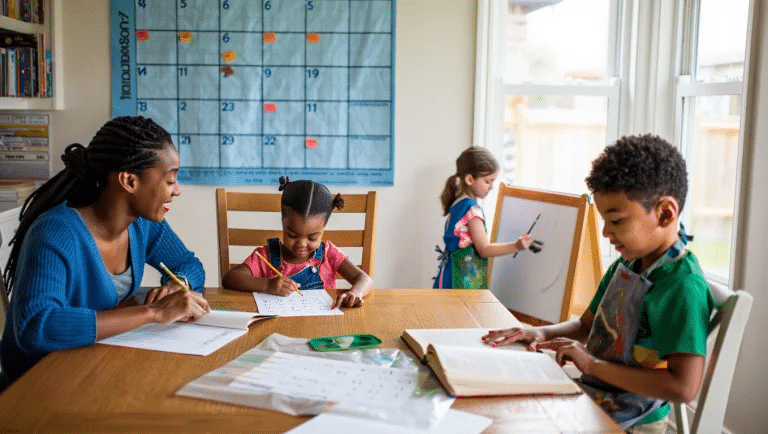Most parents who homeschool face the challenge of creating a balanced schedule that works all year.
The idea of year-round learning often feels hard to plan and keep up with. Many families want structure without the stress of a tight calendar.
Year-round homeschool plan can offer more freedom and less burnout for both parents and children. This approach breaks the typical school-year mold and creates a rhythm that fits real family life.
This blog shows how to build a year-round homeschool schedule that bends with your family’s needs. It covers the benefits, practical tips for making your plan, and ways to adjust as you go forward.
What is Year Round Homeschool Schedule?
A year-round homeschool schedule spreads learning throughout all 12 months instead of following the usual nine-month school year with a long summer break.
Families who use this method still teach the same amount, but they space it out with more frequent, shorter breaks. This approach allows for 4-6 weeks of lessons followed by 1-2 weeks off, repeating this pattern across the year.
Some families might do school four days a week instead of five, or they might have shorter daily sessions that happen more often.
The key point is flexibility. A mom might plan six weeks of math and reading, then take a week off for family time. Or she might schedule lighter days during busy seasons like December.
Unlike traditional school calendars, a year-round plan can shift when needed for trips, illness, or special events. The main goal is steady learning without long gaps.
Year Round Homeschool Schedule Ideas

Here are 7 year round Homeschool Schedules that you can use
1. Six-Week Cycle Plan
The six-week cycle works like a steady beat in music. You do school work for six weeks straight, then take a full week off to rest.
This plan keeps kids from getting too tired, and the regular breaks give everyone something to look forward to.
With this plan:
- School happens for 42 days in a row
- Then comes a 7-day break with no formal lessons
- Breaks fall about once every other month
- You still fit in about 180 school days each year
- The week off can be used for trips, doctor visits, or just relaxing
2. Four-Day School Week
This plan keeps school days to just Monday through Thursday. Every Friday becomes a free day for fun stuff, outings, or extra help with hard subjects.
Kids like knowing they always have a three-day weekend coming up!
With this plan:
- The school runs four days each week all year
- Fridays become days for museums, parks, or hands-on projects
- Weekly schedule stays the same year-round
- Kids get a break before they get too tired
- Parents can use Fridays for planning or one-on-one help
3. Seasonal Adjustment Plan
This plan changes with the weather. During cold or rainy months, you might do more bookwork.
When it’s nice outside, you can cut formal lessons short and let nature be the classroom. Your daily hours shift based on the season.
With this plan:
- Winter might mean 4-5 hours of daily lessons
- Summer could drop to just 1-2 hours of basics
- Spring and fall offer a mix of indoor and outdoor learning
- The yearly total hours stay the same
- The family can enjoy good weather when it comes
4. Morning-Only Method
With this plan, all the must-do work happens before lunch. Math, reading, writing, and other main subjects get done early when most kids can focus better. After lunch, the day opens up for free learning, hobbies, and play.
With this plan:
- School work runs from about 8 am to noon
- Afternoons stay free for clubs, play, or quiet reading
- The daily end time is clear and easy to stick to
- Kids learn to work well, knowing there’s a time limit
- Busy families can plan outside events for afternoons
5. Sabbath Schedule
This year round homeschool schedule borrows the idea of rest from the word “sabbath.” After six weeks of regular school work, the whole seventh week becomes a break. This creates a nice rhythm of work and rest throughout the year.
With this plan:
- Six weeks of normal lessons
- Every seventh week is completely school-free
- The pattern repeats about seven times per year
- Breaks happen about once every two months
- The time off helps both parents and kids stay fresh
6. Two-Month On, Two-Week Off
With this plan, you group school days into bigger blocks. You do about eight weeks of lessons, then take a nice long two-week break.
These longer breaks give time for big trips without cutting into too many school days.
With this plan:
- Eight weeks of steady schooling
- Two full weeks off between each block
- Four or five longer breaks happen each year
- Vacations can fit neatly into the time off
- Longer learning blocks let kids go deeper into topics
7. Year-Round Half Days
This gentle plan spreads learning in small daily doses across the whole year.
Instead of long school days, you might do just 2-3 hours of formal lessons year-round, with few big breaks. This keeps learning steady but never too much.
With this plan:
- Short, sweet lessons happen daily
- No day feels too long or too hard
- Kids retain more with daily practice
- The light schedule prevents school stress
- Small breaks (1-3 days) can happen as needed
Tools that Can Help in Making Year Round Homeschool Schedule
Creating a consistent and flexible homeschool schedule that works year-round requires the right tools. These resources can streamline your planning, help track progress, and allow you to balance academics with life’s curveballs.
Below are some top tools, with a link to get started:
| Tool | What It Does |
|---|---|
| Plans lessons, tracks grades, reschedules automatically and includes shopping lists. | |
| Google Calendar | Schedules the school year with color-coded subjects and shared events. |
| Planbook | Organizes lessons by day, week, or month; supports attachments and edits. |
| Notion | Custom dashboard for tracking lessons, reading logs, and unit studies. |
| Evernote | Saves notes, articles, and ideas; easy to organize by subject or month. |
| MySchoolYear | Manages grades, attendance, schedules, and creates transcripts. |
Benefits of a Year-Round Homeschool Schedule
Switching to a Year round homeschool schedule approach offers many benefits for both parents and kids. This style of learning aligns with how our brains function best and helps make school feel less like a chore and more like a natural part of life.
- Less summer learning loss since kids don’t have long gaps without practice
- Shorter daily lessons that help kids stay focused and interested
- Fewer burnout moments for parents who don’t have to cram everything into nine months
- Better chance to match learning with real-life events like holidays, births, or moves
- More time to slow down for complex topics instead of rushing to finish by June
- Easier to plan around weather, taking time off during nice days, and doing more indoor work during bad weather
Wrapping Up
Year-round homeschooling gives families the gift of time to learn at their own pace, take breaks when needed, and build a life where learning fits naturally into each day.
The key is picking a plan that works for your specific family.
Try one of these seven schedules for a few months and watch how your kids respond. Keep what works, change what doesn’t, and remember that your plan can grow as your family does.
Want more help? Leave a comment below about which schedule you’re thinking of trying. You can also check out our printable planning sheets to create your year-round calendar.




